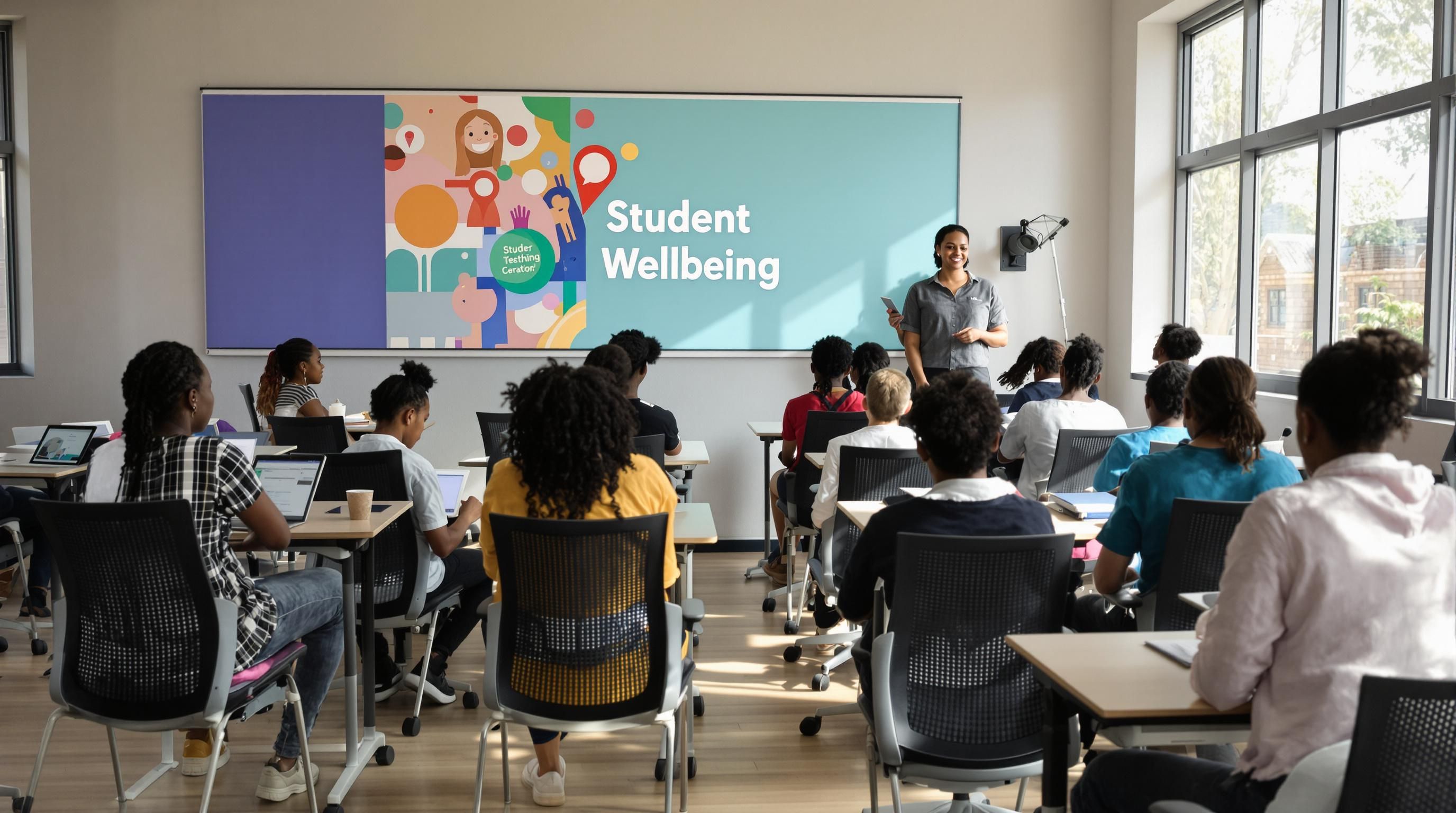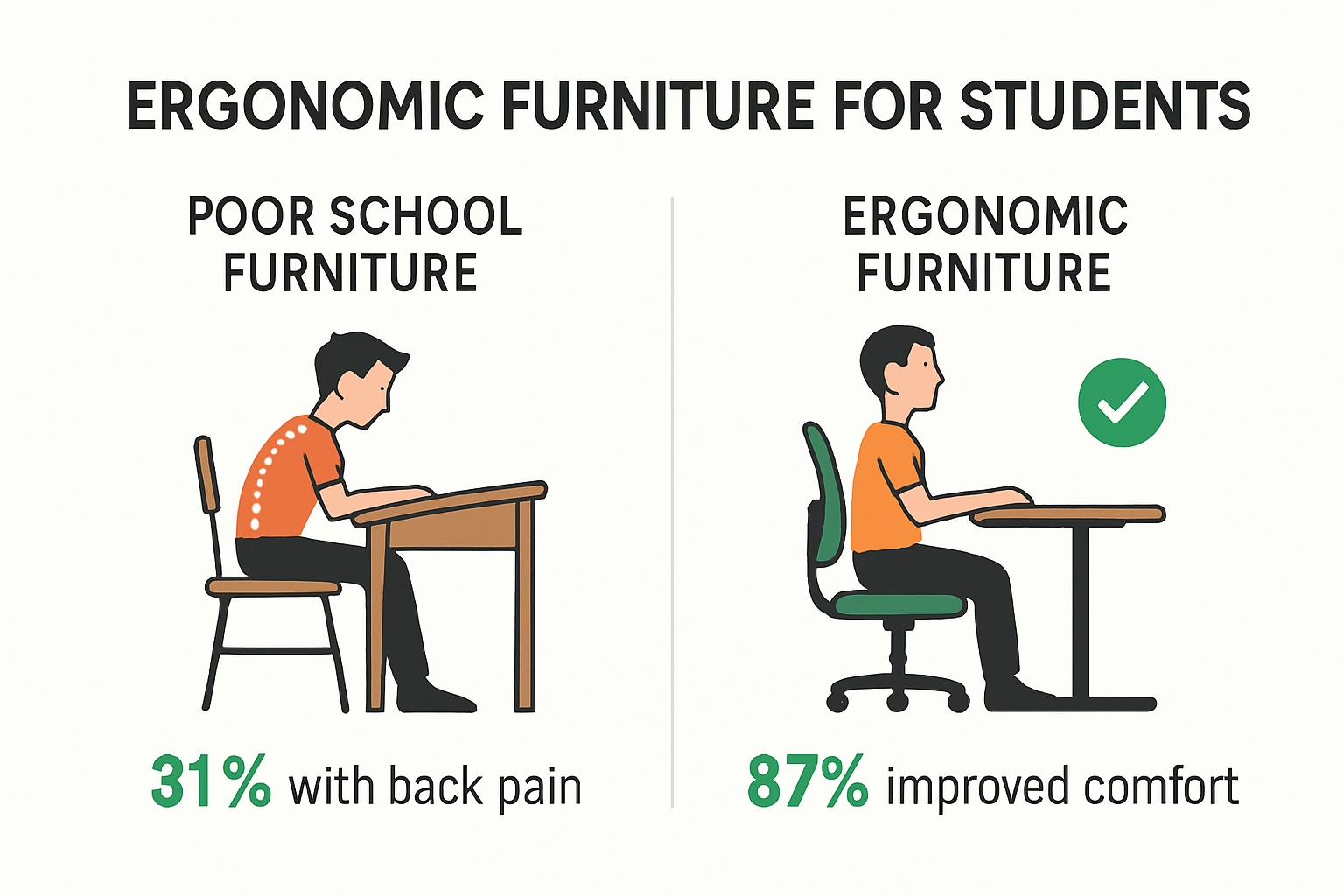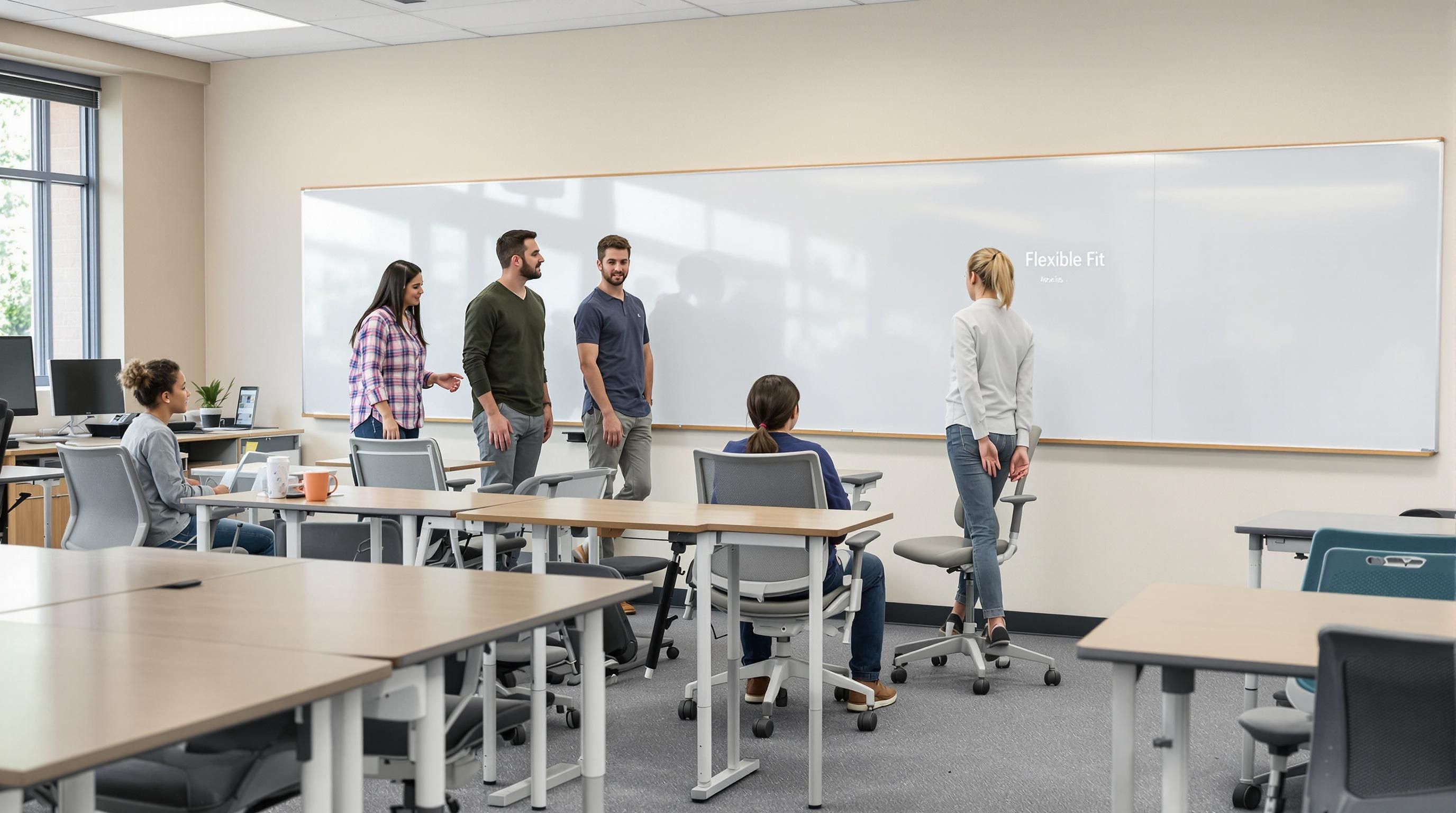Ergonomic Furniture for Schools: 2025 Guide for Southern Africa
Jul 26, 2025
Ergonomic Furniture for Schools: 2025 Guide for Southern Africa

School desks and chairs might look the same in every classroom, but their design sets the foundation for student wellbeing across southern Africa. Get this: over 60 percent of students report back pain and discomfort linked to poor furniture, which seriously affects not just health, but also focus and learning. What hardly anyone realises is that choosing the right ergonomic furniture is about way more than just comfort – it is a long-term investment that shapes academic success and physical development for years to come.
Table of Contents
- Why Ergonomic Furniture Matters For Schools
- Choosing The Right Ergonomic Solutions For Institutions
- Benefits For Businesses And Organisations In Southern Africa
- Practical Tips For Implementing Ergonomic Furniture
Quick Summary
| Takeaway | Explanation |
|---|---|
| Invest in ergonomic furniture for health | Ergonomic furniture reduces musculoskeletal issues and improves student posture, enhancing overall well-being. |
| Ergonomics boost academic performance | Properly designed furniture helps students focus better and reduces discomfort, encouraging active engagement in learning. |
| Consider adjustable and modular designs | Furniture must accommodate different body sizes and learning preferences to support diverse student needs effectively. |
| Implement ongoing training for users | Educators and students need training on furniture adjustments to maximize ergonomic benefits and ensure proper usage. |
| Regularly monitor furniture effectiveness | Continuous assessments help identify necessary adjustments and ensure furniture remains conducive to student health and learning. |
Why Ergonomic Furniture Matters for Schools
Ergonomic furniture represents a critical investment in students’ physical health, academic performance, and long-term well-being. In southern African educational environments, understanding the profound impact of carefully designed school furniture goes far beyond simple comfort.
The Health Implications of Poor School Furniture Design
Students spend substantial portions of their day seated, making furniture design a crucial factor in preventing potential health complications. Research from the International Journal of Environmental Research and Public Health reveals that mismatched furniture dimensions can lead to significant musculoskeletal challenges. When school furniture does not align with students’ body proportions, they experience increased physical strain, potentially resulting in chronic back pain, poor posture, and reduced concentration levels.
The biomechanical stress caused by inappropriate furniture can trigger long-term health issues. Developing bodies are particularly vulnerable to environmental ergonomic conditions. Chairs that are too high or desks that do not accommodate proper writing angles can cause unnecessary muscular tension, spinal misalignment, and discomfort that extends beyond classroom hours.

Academic Performance and Ergonomic Considerations
Beyond physical health, ergonomic furniture directly influences academic performance. When students are physically uncomfortable, their ability to focus and engage with learning materials diminishes dramatically. Proper ergonomic design ensures that students can maintain optimal posture, reduce physical fatigue, and sustain mental concentration during extended study periods.
Ergonomically designed school furniture creates an environment that supports cognitive function. Chairs with appropriate lumbar support, adjustable heights, and desks that facilitate natural writing positions enable students to channel their energy into learning rather than managing physical discomfort. This approach transforms classroom furniture from mere functional objects into strategic tools for educational excellence.
Long-Term Developmental Impact
The implications of ergonomic furniture extend far beyond immediate classroom experiences. Developing bodies require supportive environments that promote healthy physical development. Poorly designed furniture can contribute to postural problems, muscular imbalances, and potential long-term skeletal issues that may persist into adulthood.
Schools that prioritize ergonomic furniture design demonstrate a commitment to holistic student well-being. By investing in furniture that adapts to growing bodies, educational institutions can play a proactive role in preventing future health complications. This approach represents more than a design choice—it is a fundamental investment in students’ physical and academic potential.
Ultimately, ergonomic furniture for schools is not a luxury but a necessity. It represents a sophisticated understanding of how physical environment directly influences learning capacity, health outcomes, and overall student development. Southern African educational institutions have a unique opportunity to lead in creating supportive, health-conscious learning spaces that prioritize student well-being.
Choosing the Right Ergonomic Solutions for Institutions
Selecting appropriate ergonomic furniture for educational institutions requires a strategic approach that balances student needs, budget constraints, and long-term functionality. Southern African schools must consider multiple factors to create learning environments that support physical health and academic performance.
Anthropometric Considerations and Furniture Sizing
Research from an international ergonomic study highlights the critical importance of matching furniture dimensions to students’ body measurements. The study, which analyzed anthropometric data from 380 university students, revealed that standard furniture often fails to accommodate diverse physical characteristics. Educational institutions must prioritize furniture that can be adjusted or customized to accommodate varying student body sizes and proportions.
Key considerations include adjustable chair heights, flexible desk configurations, and modular designs that can adapt to different age groups and physical requirements. Flexible seating classrooms represent an innovative approach, allowing students to choose seating arrangements that best support their individual learning and physical comfort needs.

Technology Integration and Ergonomic Design
Modern educational environments demand furniture solutions that seamlessly integrate technological requirements. Research exploring classroom management techniques demonstrates how strategic seating arrangements can minimize student distractions while supporting digital learning environments. This involves creating furniture solutions that accommodate laptops, tablets, and other digital learning tools without compromising ergonomic principles.
Institutions should seek furniture with integrated cable management, appropriate device support surfaces, and designs that encourage proper posture during digital learning activities. Ergonomic solutions must balance technological functionality with physical comfort, ensuring students can engage with digital resources without experiencing unnecessary physical strain.
Sustainable and Adaptable Furniture Investments
Choosing ergonomic solutions is not merely about immediate comfort but represents a long-term investment in student health and institutional efficiency. Educational leaders must evaluate furniture options based on durability, adaptability, and potential for future reconfiguration. Materials that withstand frequent use, designs that can be easily modified, and furniture with multiple adjustment capabilities provide the most value.
Consider furniture solutions that offer:
- Modular design capabilities
- Multiple adjustment points
- Robust construction materials
- Compatibility with different learning environments
- Potential for future technological integrations
Institutions in southern Africa face unique challenges in creating optimal learning environments. By prioritizing ergonomic furniture that addresses physical, technological, and developmental needs, schools can create spaces that truly support student potential. The right furniture is more than a physical object—it is a strategic tool for enhancing educational experiences and supporting holistic student development.
To help compare the key considerations for selecting ergonomic furniture, the following table summarizes the primary features to prioritise and their benefits:
| Feature | Importance | Benefit |
|---|---|---|
| Adjustable chair heights | High | Accommodates different body sizes for better posture |
| Modular/flexible desk configurations | High | Adapts to varied learning styles and classroom activities |
| Multiple adjustment points | Medium | Allows for ongoing adaptation as students grow |
| Robust construction materials | High | Ensures durability and longevity |
| Integrated cable/device management | Medium | Supports digital learning without clutter |
| Easy reconfiguration for new environments | Medium | Facilitates learning space updates as needs change |
Benefits for Businesses and Organisations in Southern Africa
Ergonomic furniture extends far beyond immediate physical comfort, representing a strategic investment with profound implications for businesses and organizations across southern Africa. By understanding the comprehensive benefits of ergonomic solutions, institutions can transform their approach to workplace and educational environments.
Workforce Development and Future Productivity
Research from the South African Journal of Industrial Engineering demonstrates that ergonomically designed environments play a crucial role in developing a healthier, more capable workforce. When educational institutions invest in ergonomic furniture, they directly contribute to reducing musculoskeletal disorders and improving student concentration, which ultimately translates into more productive future employees.
Businesses benefit from this long-term approach by receiving graduates who have been educated in environments that prioritize physical well-being and cognitive performance. The ergonomic principles learned during educational years become ingrained habits that carry forward into professional settings, potentially reducing workplace injuries and enhancing overall organizational efficiency.
Economic Impact and Healthcare Cost Reduction
Research conducted in Ghana reveals that mismatched classroom furniture contributes to significant health complications. By proactively addressing ergonomic challenges in educational settings, southern African organizations can substantially reduce future healthcare costs associated with musculoskeletal disorders.
The economic implications are substantial. Preventing early-onset physical complications through proper ergonomic design means reduced healthcare expenses, lower employee absenteeism, and increased overall workplace productivity. Organizations that recognize and invest in ergonomic solutions position themselves as forward-thinking entities committed to holistic employee well-being.
Competitive Advantage and Institutional Reputation
A comprehensive study in Nigerian tertiary institutions highlighted how ergonomic furniture positively influences student behavior and reduces physical strain. For businesses and organizations in southern Africa, this translates into a powerful competitive advantage.
Institutions that prioritize ergonomic solutions demonstrate a commitment to progressive practices, attracting top talent and enhancing their reputation. Whether in education, corporate environments, or specialized sectors, ergonomic furniture signals an organization’s dedication to employee health, innovation, and long-term strategic thinking.
The benefits of ergonomic furniture extend far beyond immediate physical comfort. They represent a comprehensive approach to human capital development, organizational efficiency, and sustainable growth. Southern African businesses and institutions that embrace these principles are not just purchasing furniture—they are investing in their most valuable asset: human potential.
To clarify how ergonomic furniture impacts various organisational outcomes, this table highlights the key benefits for schools, businesses, and the wider economy:
| Organisational Benefit | Description | Impact Area |
|---|---|---|
| Healthier future workforce | Reduces musculoskeletal disorders among students and employees | Health/productivity |
| Lower healthcare costs | Minimises injury and chronic pain-related expenses | Economic |
| Enhanced learning outcomes | Boosts student focus and academic performance | Education/workforce |
| Improved institutional reputation | Attracts talent with a reputation for innovation and care | Reputation/competitiveness |
| Increased workplace productivity | Leads to ingrained ergonomic habits and efficiency | Business performance |
Practical Tips for Implementing Ergonomic Furniture
Implementing ergonomic furniture in southern African educational institutions requires a strategic and comprehensive approach. Successful integration involves more than simply purchasing new furniture—it demands careful planning, training, and ongoing evaluation to ensure maximum benefit for students and staff.
Assessment and Strategic Planning
Research published in the journal Ergonomics highlights a critical insight: providing ergonomic furniture alone does not guarantee improved posture or comfort. Institutions must develop a systematic implementation strategy that includes comprehensive risk assessment, detailed measurement of existing furniture, and precise matching of furniture to student anthropometric characteristics.
Key assessment steps include:
- Conducting detailed physical measurements of student body sizes
- Evaluating current furniture’s ergonomic limitations
- Creating a phased implementation plan
- Budgeting for gradual furniture replacement
- Identifying high-priority learning spaces for initial ergonomic upgrades
Training and User Education
The Victorian Department of Education’s guidelines emphasize that effective ergonomic implementation requires comprehensive user training. Simply installing new furniture is insufficient—students and educators must understand how to utilize ergonomic features correctly.
Implementation should include:
- Workshops demonstrating proper furniture adjustment techniques
- Visual guides explaining correct sitting postures
- Regular ergonomic awareness sessions
- Mechanisms for ongoing feedback and furniture optimization
Continuous Monitoring and Adaptation
Guidelines from the European Agency for Safety and Health at Work underscore the importance of continuous monitoring in ergonomic environments. Institutions must develop robust systems to track the effectiveness of their ergonomic furniture investments.
Recommended monitoring strategies include:
- Periodic physical health assessments of students
- Surveys capturing comfort and usability feedback
- Biomechanical assessments of student postures
- Regular equipment maintenance and adjustment protocols
Successful ergonomic furniture implementation in southern African schools transcends simple furniture procurement. It represents a holistic approach to student well-being, involving careful planning, continuous education, and adaptive management. By viewing ergonomic furniture as a dynamic, evolving system rather than a static solution, educational institutions can create learning environments that genuinely support student health and academic potential.
Frequently Asked Questions
What is ergonomic furniture for schools?
Ergonomic furniture for schools is designed to support students’ physical health and well-being, promoting proper posture and reducing discomfort during long periods of sitting. It includes features like adjustable heights and lumbar support.
Why is ergonomic furniture important for students?
Ergonomic furniture is crucial for students as it helps prevent musculoskeletal issues, enhances concentration, and improves overall academic performance by providing a comfortable learning environment.
How do I choose the right ergonomic furniture for my school?
When choosing ergonomic furniture, consider anthropometric factors, adjustability, material durability, and the furniture’s ability to integrate technology. Ensure it meets the diverse needs of students.
What are the long-term benefits of investing in ergonomic furniture?
Investing in ergonomic furniture leads to healthier students with better posture, reduces future healthcare costs, enhances academic performance, and improves the institution’s reputation as a forward-thinking educational environment.
Upgrade Your Classroom Comfort and Performance with Office Stock
Every school faces the real challenge of outdated or mismatched furniture, often leading to student discomfort, lower focus and even long-term health issues. If you recognise these problems from the “Ergonomic Furniture for Schools: 2025 Guide for Southern Africa,” you know how crucial ergonomic solutions are for student health, posture and concentration. The right furniture is more than a convenience. It is a real investment in classroom success and the wellbeing of your learners. Our team at Office Stock understands the vital role flexible, durable, and supportive furnishings play in southern African schools of every size.

Transform the way your school supports students. Get in touch with us to access premium quality ergonomic office chairs and desks designed to match the needs identified in your ergonomic assessment. With expert advice, prompt delivery and trusted local support, Office Stock brings you closer to healthier classrooms today. Visit https://officestock.co.za and make your next move towards a more comfortable, productive and future-ready learning space.
